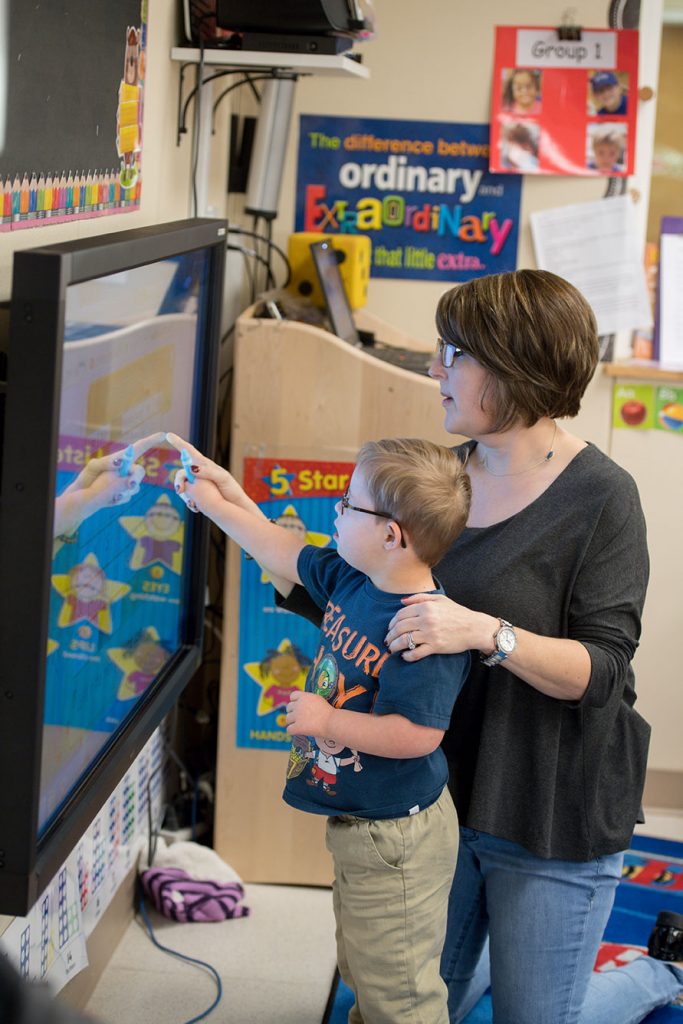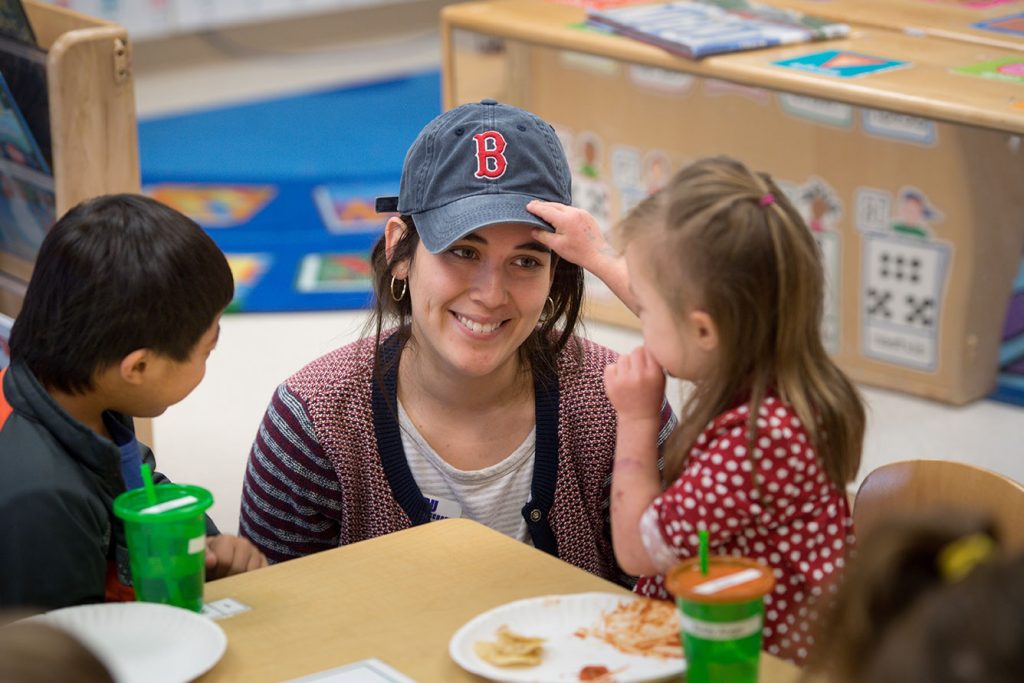
KinderFrogs Overcome Developmental Delays
Preschoolers with Down syndrome prep for traditional classrooms.
Nya Johnson’s parents did not pursue genetic testing before her birth in 2011. In the delivery room, her mother noticed right away that their child had Down syndrome.
The premature infant spent her first three weeks in a neonatal intensive care unit, while her parents scrambled to learn about raising a child whose development is altered by an extra chromosome.
Nya’s father, Darian Johnson, said one of his daughter’s nurses mentioned KinderFrogs, the early intervention preschool for children with Down syndrome and other developmental delays founded in 2000. The program, which shares a campus building with Starpoint School, is the only one to serve youngsters with Down syndrome in Tarrant County.
Nya’s parents put her on the waiting list. She joined KinderFrogs after she passed the 18-month mark.
Kristen Adams, who started teaching at KinderFrogs in 2001, said parents are often reluctant to drop tiny toddlers off at a five-day-a-week preschool. “It’s very difficult for them to kind of let go of their child.”
Handing off a child who might have required extra parental care is a “big jump,” Adams said. But early therapy is the core function of KinderFrogs, where the goal is to get children ready for inclusion in a mainstream kindergarten.
Nya’s father said integration into the mainstream is the plan for his daughter. “I guess the paradigm from years past was just to put [kids with Down syndrome] in a room with other special-needs kids, and that’s it,” Johnson said. “But that’s really not acceptable for most parents now.”
People with Down syndrome “are individuals, & they’re independent. They have hopes, and they have goals for their lives just like anybody else.”
KinderFrogs teacher Kristen Adams
DEVELOPMENT ASSISTANCE
To catch up with their peers by kindergarten, Adams said children with Down syndrome need early help. The children often have heart issues that require corrective surgery in infancy. Even without serious medical issues, the children often have low muscle tone, which prevents them from eating and playing like a typical toddler.
When most KinderFrogs students enter the preschool, they cannot chew anything with more texture than baby food, much less walk. The children learn to stand and gain mobility with the help of Amanda Young ’09, the adapted physical education teacher for KinderFrogs and Starpoint. A physical therapist also visits the school once a week.
The preschoolers then tackle more complex physical activities, from running to skipping to dribbling a ball, Young said. “One of their favorite games is Duck, Duck Goose.”
KinderFrogs students receive speech, occupational and music therapy in addition to preschool-appropriate reading and writing lessons as they progress through the three levels at the preschool.
Each KinderFrogs class includes a few children without developmental delays, who serve as models for appropriate behavior.
Preschool-age children don’t see developmental differences, Adams said, but interacting with children who are developing at a typical pace benefits those who are not. “It really helps the students with Down syndrome to build their language and play skills.”

Early therapy is the core function of KinderFrogs, where the goal is to get children ready for inclusion in a mainstream kindergarten.
AN UNDERSTANDING COMMUNITY
KinderFrogs also benefits parents, especially through the close-knit parent-teacher association. The group brings developmental specialists to speak, invites parents of former students to share their kids’ experiences in mainstream schools and organizes social gatherings.
Johnson said learning what he might encounter as Nya ventures into elementary school calmed his nerves. The parent association helped him work through fears of how his daughter might be treated outside of the supportive KinderFrogs environment.
“You’re able to talk to other parents and able to understand some of the challenges they’ve dealt with because they’re further along in their journey,” Johnson said.
Nya’s mainstream debut is coming soon. This school year she is in Adams’ L.E.A.P. class, where students ages 5 and 6 participate in a mock kindergarten. The children learn classroom essentials, such as gluing and following instructions, in between play and therapy sessions.

Teachers and students work with KinderFrogs to prepare them to succeed in school.
CLEARING MISCONCEPTIONS
Nya, who learned to read before 5, is doing so well that teachers use her to model behavior for other students in the L.E.A.P. class, Johnson said. “She has books everywhere. She even loves to read in the car.”
The girl’s intelligence might surprise some people, Adams said, because children with the diagnosis are often misperceived.
Because people with Down syndrome often take a few extra seconds to process information, others sometimes consider them to be unintelligent, Adams said, but anyone of that opinion has it wrong. People with the syndrome “may need an accommodation or two in order to carry out something independently,” she said. “But they are individuals, and they’re independent. They have hopes, and they have goals for their lives just like anybody else.”
When KinderFrogs students leave her classroom, Adams hopes her efforts will pave the way to lifelong success. Often, she said, parents are just as upset when they leave the program with a capable 5-year-old as they were when they dropped off an 18-month-old who could not walk.
But after KinderFrogs, Adams said, parents feel more confident about their child’s ability to succeed in school and in life. “We allow the families to increase their expectations.”
Although Johnson is nervous about sending his daughter off to kindergarten next year, he is also excited about seeing what Nya’s future holds. “This place has really changed the course of her life,” he said. “I know it has.”

Your comments are welcome
2 Comments
Related reading:
Features
Starpoint School’s Special Education
At age 50, the on-campus lab school is still giving students a chance to shine.
Features
Adam Fung’s Uncommon Arctic Adventure
The art professor is acting as an Arctic ambassador and filmmaker after his 19-day residency in the Far North.